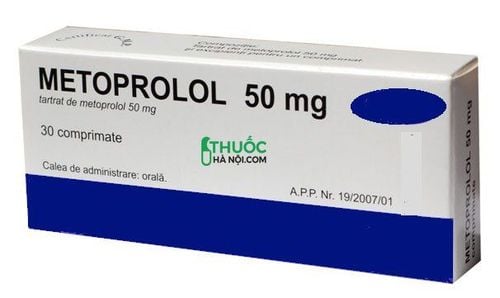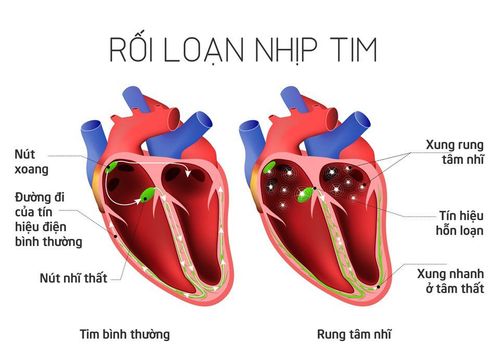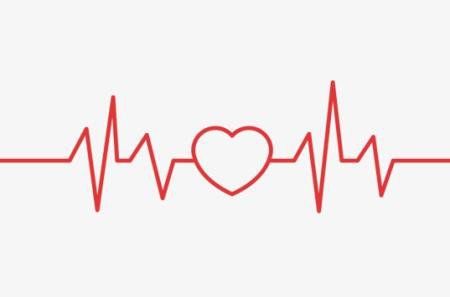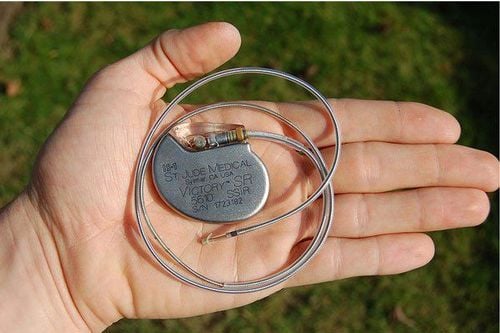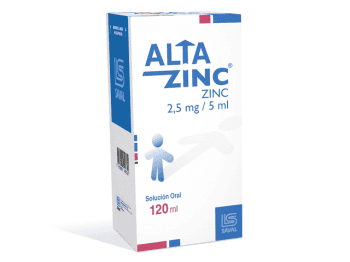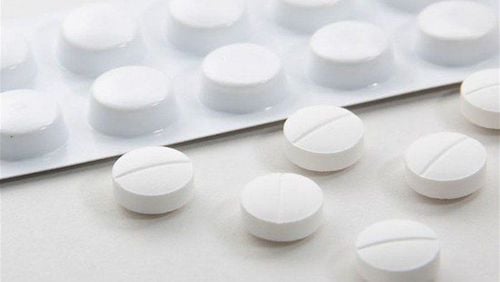This is an automatically translated article.
The article is professionally consulted by Master, Doctor Cao Thanh Tam - Cardiologist - Cardiovascular Center - Vinmec Central Park International General Hospital.
Pacemaker is a special electronic device used in medicine to assist in regulating heart rhythm in patients with irregular heart rhythms in cardiovascular diseases such as arrhythmias, post-traumatic injuries. Myocardial infarction or heart valve disease... The following article will share the most basic knowledge about pacemakers as well as pacemaker operation.
1. What is a pacemaker?
The heart is the most important organ of the body, keeping an important function in the circulatory system. The heart is like a pump, helping to pump blood carrying nutrients and oxygen along the arteries to organs in the body to nourish and ensure the vital activities of all internal organs. as well as cells. Thanks to the heart, all vital activities of the body are maintained stably. Therefore, any disorder that occurs in the heart has an effect on the body.
Of all heart problems, arrhythmia is the most common condition that causes many effects on the body such as:
Fatigue, weakness Fainting, fast or slow heartbeat depending on the patient and other influencing factors. Chest pain, shortness of breath In some severe cases, due to insufficient blood supply for brain and body activities, it can cause cerebrovascular accident leading to hemiplegia, even death. To limit this situation, in 1889, people began to conduct studies on the electrical impulses of the heart. In 1956, in the United States, the first successful implantation of a pacemaker was carried out in the United States, and in 1973, Vietnam succeeded with the first transplant in the country. Due to economic conditions, it was not until 1990 that pacemakers were strongly developed and increasingly popular in Vietnam.
Pacemaker is one of the special electronic devices used to assist in cardiovascular diseases. Pacemaker has two outstanding features:
First: The machine has the ability to detect and analyze the functional activities in the electrical system of the heart. Second: After analyzing the electrical function of the heart, the pacemaker will rely on it to automatically generate periodic DC pulses and then through direct stimulation electrode wires. into the heart muscle, thereby causing the heart muscle to contract according to that same cycle. This is the action of the pacemaker in the body to support to ensure that the functioning of the heart is not impaired or interrupted. The structure of the pacemaker consists of two main parts, the pacemaker and the electrode wire.
Pacemaker:
This is the main part of the pacemaker. Pacemaker structure includes: Battery: With today's pacemakers mainly use Lithium - lodin batteries due to their long-term use characteristics, which can ensure operating energy for the machine in the range of 8 to 10 five. The connector to the electrode is made of epoxy resin with sockets for connecting the electrode wires together. There are also microprocessors, memory and electronic circuits capable of storing programs and ensuring proper functioning of the pacemaker.
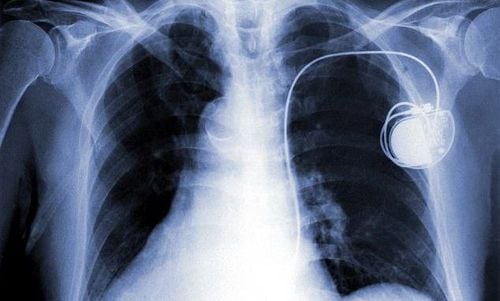
Pacemakers as well as all other devices or factors outside the body, when entering the body, according to the immune mechanism, it is recognized as a foreign antigen that needs to be destroyed and eliminated. out of the body. To overcome this, to help the pacemaker can work normally in the body without being detected, people have used alloy material to make a shell that wraps around the battery and processor. This alloy shell is suitable for the body's physiological conditions, so the body cannot recognize the pacemaker.
Electrode wire ( Electrode ):
Is a very important component of the pacemaker. The structure of the electrode wire consists of 3 parts: The electrode wire head is directly attached to the heart muscle, responsible for detecting the electrical activity of the heart and transmitting the DC electrical impulses of the pacemaker to the heart muscle. Therefore, this electrode tip is specially made to be able to fix well on the heart muscle wall while minimizing fibrosis at the attachment site
Electrode body
Direct electrode wire base with pacemaker
To insert a pacemaker into the body, people can put it in two ways: Place the machine under the endothelium or place it on the pericardium. Pacemakers can be placed temporarily or permanently in the body depending on the patient's health status and comorbidities.
Implanting a pacemaker into the body is also a complicated surgery, so there may still be some risks encountered during the implantation process such as:
Pain in the grafting area often occurs at the beginning of insertion machine Possible swelling, bleeding at the transplant site Infection due to inadequate aseptic factors before, during and after surgery Damage to blood vessels and nerves at the site as well as in the vicinity Pulmonary collapse Reaction to pacemakers and medications
2. Indications for pacemaker placement and notes for patients after implantation
Indications for the use of pacemakers apply to irregular heartbeats in cardiovascular diseases such as:
Arrhythmias (commonly applied to patients with bradycardia) due to congenital , due to age, due to atrial fibrillation , or complications after myocardial infarction ... Congenital heart disease. Heart valve disease, especially the case after open heart valve surgery Heart failure. Hypertrophic cardiomyopathy with left ventricular outflow tract obstruction Notes for patients using a pacemaker:
Before, during and after the pacemaker is placed in the body, the patient should be closely monitored in the hospital . The doctor needs to check the activity of the pacemaker in the body, adjusting it to suit each patient. If there are no abnormal problems during the follow-up, the patient can be monitored at home, periodically examined at the time points after implantation 1 month, 3 months and every 6 months. If you notice any abnormality in your body, contact your doctor as soon as possible. After implantation of the pacemaker, the patient can move around and do normal activities. Limit heavy, strenuous work, do not play sports. When driving, it is important to always wear the seat belt and avoid crossing the seat belt over the pacemaker area. Do not listen to the phone in the ear on the same side of the pacemaker as the phone signal may interfere with the device. The patient was on a pacemaker, and was not allowed to have magnetic resonance imaging even up close. Be aware of all electronic devices that have magnetic or magnetic fields such as magnets as this can interfere with the functioning of the pacemaker.
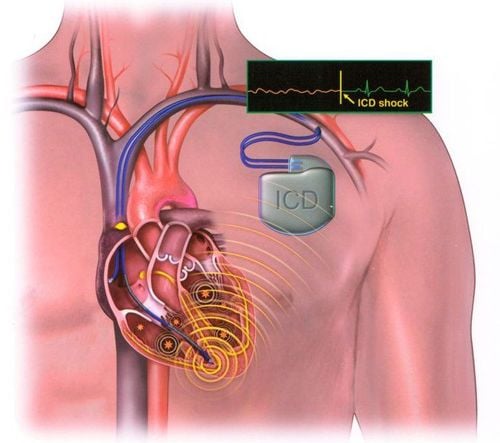
In general, a pacemaker is an electronic device that is primarily used to support the functioning of the cardiovascular system. Along with supporting cardiovascular health, there are also other risks associated with the machine if it is not used properly and strictly followed the instructions of the doctor before, during and after surgery.
To protect cardiovascular health in general and detect early signs of myocardial infarction and stroke, customers can sign up for Cardiovascular Screening Package - Basic Cardiovascular Examination of Vinmec International General Hospital . The examination package helps to detect cardiovascular problems at the earliest through tests and modern imaging methods. The package is for all ages, genders and is especially essential for people with risk factors for cardiovascular disease.
If you have a need for consultation and examination at Hospitals under the national health system, please book an appointment on the website to be served.
Please dial HOTLINE for more information or register for an appointment HERE. Download MyVinmec app to make appointments faster and to manage your bookings easily.





